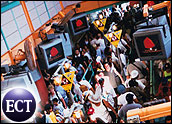As CRM solutions emerged, retailers with private-label credit cards and catalog operations adopted the technology with the clarity many other retailers lacked. They already had a wealth of information, and they understood that CRM provided a toolset for data analysis and optimization.
“They stressed the ‘C’ in CRM because they had customer data,” says marketing consultant Mike Capizzi. “They had direct relationships with consumers.”
“Others didn’t have data, so they adopted the technology first,” he continues. Unfortunately, in the excitement to invest in cutting-edge software, many retailers failed to set goals for their CRM implementations or even to identify what type of data should be collected. Others gathered any information they could — then sat on a mountain of bits and bytes, unsure of what to do with it. Grocery retailers still get flack for this apathetic CRM approach.
“Then retail got onto a 10-year loyalty kick,” Capizzi tells CRM Buyer. “Retailers realized that the advent of CRM talk and technologies [necessitated] insight into customers and transactions.” In other words, data didn’t go into a magic black box and — Voila! — deliver greater profitability.
Retailers needed a way to identify their shoppers. They offered points, discounts, and payment tools in return for names, addresses, and archival visibility into purchase transactions. To get to greater profitability, they began to quantify a variety of characteristics: average transactional monetary value by the customer, lifetime value of individual shoppers to the brand, and product relevance to distinct consumer segments.
Evolution and Learning
“It’s pretty close to an even playing field now,” Capizzi says. The emergence of CRM and loyalty marketing efforts have enabled retailers to study attitudes of defined customer groups on a much broader scale than traditional market research methods — such as focus groups and mall intercepts — previously allowed.
CRM also captures transactional data collected through proprietary payment tools and point-of-sale software. Now retailers are marrying the “what” of behavioral data to the “why” of attitudinal data.
“They know what’s happening and the emotional triggers behind the activity,” says Capizzi.
CRM was a prerequisite for today’s sophisticated retail marketing systems. “If retailers didn’t have [CRM], they wouldn’t have metrics. Without metrics, there’d be no merger of consumer attitudes and behavior,” he explains.
This type of intelligence helped Wal-Mart to respond effectively during a crisis, says Murray Forseter, publisher of Chain Store Age. “Wal-Mart has the biggest retail data set, and it uses it well,” he tells CRM Buyer.
When hurricanes were due to hit the Gulf Coast and Florida, the company rushed Pop-Tarts and beer to affected areas. “Wal-Mart has strong identification of its core customer,” Capizzi says, “and its core customer wants something to give to a scared and hungry kid to calm him down.” The beer, presumably, does something similar for scared and hungry parents.
Integrated Database, Determined Strategy
Road Runner Sports, a multichannel athletic shoe and apparel retailer based in San Diego, has a two-tiered loyalty program to which 70 percent of its customers subscribe. The Run America Club costs US$39.99 per year, and its big brother, the VIP Club, costs $54.99 annually. “They pay us to buy from Road Runner,” says founder and chief runner Mike Gotfredson. “That’s a big deal.”
Road Runner’s CRM system from Oracle tracks purchase frequency, monetary value of transactions, customers’ preferred channel, and purchased product details down to shoe and clothing colors and sizes.
Catalog shoppers, brick-and-mortar retail buyers, and online customers populate the CRM database. “The bible for Road Runner Sports is lifetime value,” Gotfredson says, and the way to live the holy word is through aggressive data analysis.
“We are a catalog marketer,” he continues. “When we drop a catalog, we know within 5 percent what sales are going to be, whether to our own list or on a prospecting basis.” Response rates to snail-mailed catalogs are between 7 percent and 10 percent among existing customers. “That’s huge and trackable,” remarks Gotfredson. Among prospects, the rate is 1.5 percent to 2 percent.
Gotfredson also advocates the merger of attitudinal data with transactional feeds from the Web, phone, direct mail, and retail stores. Customer satisfaction surveys supplement transactional information at Road Runner. “We do a lot with customers,” he says.
In addition to asking customers about their experiences with Road Runner, the retailer looks at what purchase behavior can teach.
In the past, when product models were discontinued by their manufacturers, Road Runner would contact past buyers of the product and let them know that they would need to act fast to get more of their favorite shoes. When a particular Kayano shoe was pink-slipped by manufacturer Asics, Road Runner put an outbound call center to work.
“We’d receive a 5 percent to 6 percent response rate [with the postcards],” Gotfredson says. “That’s a great home run.” Now, a week before the postcards go out, outbound telemarketing agents reach out to Run America members who’ve purchased the canceled product in the past. Reps say, “I just want to give you a heads-up. You’re a good customer. Stock up now. We want to give you first dibs,” says Gotfredson.
Road Runner has achieved greater than 25 percent response to this tactic, even when 70 percent of the outbound calls resulted in voicemail messages, not live conversations.





















































